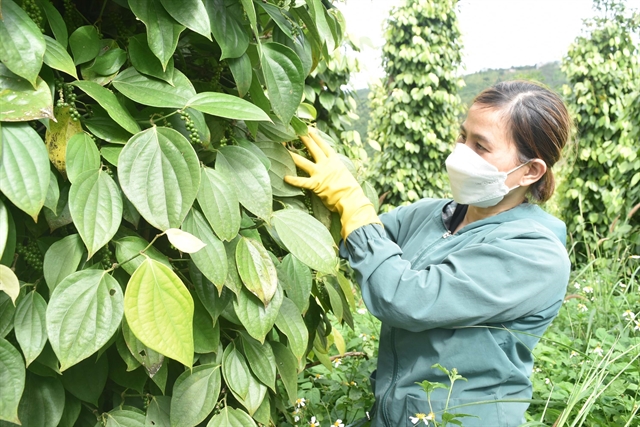 |
| A farmer works on her pepper farm in Đắk Nông. — VNA/VNS Photo Nguyên Dung |
HÀ NỘI — The positive export turnover in the first half of this year has created momentum for Vietnamese pepper to return to the group of billion-dollar export items by year-end.
Data from the Vietnam Pepper and Spice Association (VPSA) showed that Việt Nam exported 142,586 tonnes of pepper, worth US$634.2 million in H1, down 6.8 per cent in volume but up 30.5 per cent in value. Of the total, exports of black pepper reached $539.9 million, while that of white pepper hit $94.3 million.
During the period, the average price of exported black pepper was $4,365 per tonne, while that of white pepper was $5,983 per tonne, up $922 and $1,082 respectively, year-on-year.
Price hikes were also seen in the domestic market.
The online newspaper nongnghiep.vn, cited Đào Văn Lành – a pepper farmer in Đồng Nai Province’s Xuân Lộc District – as saying that the price of pepper occasionally reached VNĐ180,000 per kilo, a level that had not been reported in several years.
The price subsequently decreased but continued to be at a high level, Lành said, adding that the price of pepper in Xuân Lộc District reached VNĐ150,000 per kilo at the beginning of July, double the price of the same period last year.
Hoàng Phước Bính, Vice Chairman of the Chư Sê Pepper Association in Gia Lai Province, agreed. He said that the maximum price of pepper traded on the domestic market was VNĐ180,000 per kilo during the 2023-24 crop year. In certain regions, prices even hit between VNĐ200,000 to VNĐ210,000 per kilo.
However, this price hike was only temporary (approximately one day) due to the imperative need of certain companies to purchase pepper for export orders, Bính said.
According to Bính, the current price of pepper is in a state of fluctuation, however, it is generally on an upward trajectory as the supply of pepper in the country experienced a substantial decrease in the 2023-24 crop compared to the previous ones.
Bình anticipated that pepper prices would remain elevated in the coming years as each price increase cycle typically lasts approximately ten years.
He said that the potential for recovering the pepper cultivation area and production is not significant, in spite of the high pepper prices as current pepper producers have learned lessons from the previous price increase cycle.
Pepper prices reached a record high of over VNĐ200,000 per kilo nearly a decade ago. This prompted farmers in numerous provinces to expedite the expansion of their pepper cultivation areas, even in locations that were not conducive to the cultivation of this crop. That resulted in a surplus of pepper, which caused prices to decline steadily, causing substantial losses for numerous farmers.
Trade experts said that the expansion of pepper cultivation areas will be further restricted by the high prices and attractive profits of durian, coffee and other commodities, which directly compete with pepper in the Central Highland provinces.
Despite the current high prices of peppers, the pepper cultivation area will be unlikely to increase shortly due to a lack of agricultural labour and the difficulty farmers face in accessing bank loans to invest in pepper cultivation, they said.
Consequently, pepper cultivation areas in the Central Highlands and Southeast regions have not experienced a resurgence, despite the high prices. Rather, producers who are steadfast in their dedication to pepper are investing in the maintenance of their existing pepper gardens to reestablish their productivity, yield, and quality, nongnghiep.vn reported.
Việt Nam is profiting from a shortage of pepper supply in the global market as a result of El Nino. Experts predict that pepper production will fail to satisfy the global demand in the long term, specifically over the next three to five years. — VNS
- Reduce Hair Loss with PURA D’OR Gold Label Shampoo
- Castor Oil Has Made a “Huge” Difference With Hair and Brow Growth
- Excessive hair loss in men: Signs of illness that cannot be subjective
- Dịch Vụ SEO Website ở Los Angeles, CA: đưa trang web doanh nghiệp bạn lên top Google
- Nails Salon Sierra Madre
 VnExpress News The News Gateway of Vietnam
VnExpress News The News Gateway of Vietnam




